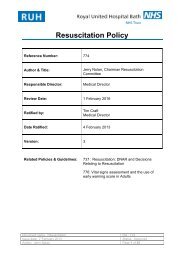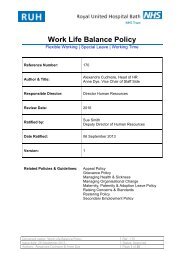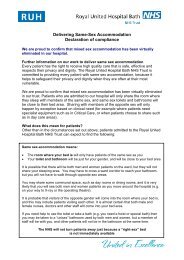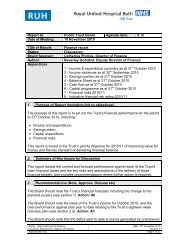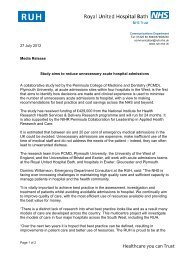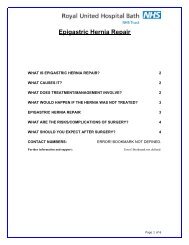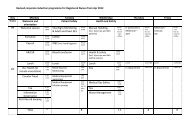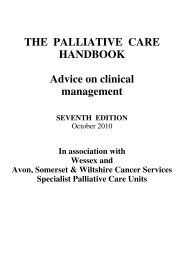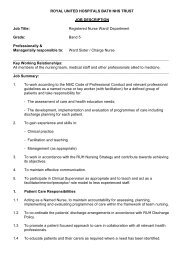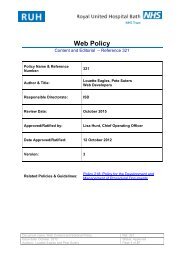Nasal Septoplasty
Nasal Septoplasty
Nasal Septoplasty
Create successful ePaper yourself
Turn your PDF publications into a flip-book with our unique Google optimized e-Paper software.
A patient information leaflet<br />
<strong>Septoplasty</strong><br />
(with/without cautery to turbinates)<br />
Introduction:<br />
Your nose consists of a cavity which is separated into two separate<br />
passages. The partition wall between the two is called the nasal<br />
septum and is mainly made of cartilage. The side walls of the nasal<br />
cavities contain fleshy-folds called turbinates. The nose warms and<br />
moistens the air we breathe. Thus the nose is an air-conditioner and<br />
filter for the lungs providing moist, warm and clean air.<br />
Reason for the operation:<br />
A common problem with the nose is to have a bent nasal septum,<br />
causing narrowing of one or both of the passages of the nose. This can<br />
make it hard to breathe through the nose. An operation can be<br />
performed to straighten the bent nasal septum. This operation is called<br />
<strong>Septoplasty</strong>. This can also include cautery to the turbinates to shrink<br />
them.<br />
About the operation:<br />
You will normally be admitted to hospital on the morning of the<br />
operation. You will be examined by the anaesthetist for your fitness for<br />
general anaesthesia.<br />
The operation itself takes up to one hour. It is carried out through the<br />
nostrils. We make a cut inside your nose and straighten out the<br />
septum by taking away some cartilage and bone, and moving the rest<br />
of the septum back to the middle. We close it back up with some<br />
stitches that dissolve on their own. If the fleshy turbinates are too big<br />
we will shrink them at the same time with electric cautery. There are<br />
no cuts on the outside. There is no swelling or bruising of the nose.<br />
There is little pain after the operation.<br />
After the operation, your nose might have a small sponge inserted into<br />
it to stop bleeding. This could be left in the nose for a few hours or<br />
Produced by the ENT department, RUH Last updated: 2006<br />
Page 1 of 3 Review date : 01/04/2007
A patient information leaflet<br />
even overnight. If you stay in overnight you will usually be allowed<br />
home the next day. You will usually need two weeks off work.<br />
What to expect after the operation:<br />
Your nose if likely to be more stuffy than before the operation. This<br />
stuffiness can be reduced by snorting-up warm water with salt, and<br />
the nurses will explain how to do this. There will be some dark<br />
bloodstained mucous discharge from the nose. This is quite normal.<br />
After the first week, the stuffiness will start to become less and two<br />
weeks after the operation the nose should start to be better than<br />
before the operation. It can take four to six weeks before the nose is<br />
completely settled. You may or may not need to come back to the<br />
clinic after the operation.<br />
The risks of the operation:<br />
<strong>Septoplasty</strong> is safe but every operation carries some small risks. There<br />
is a risk of bleeding after the operation, which may require insertion of<br />
sponges in the nose. There can be bleeding from the nose any time up<br />
to a week after surgery, but this is uncommon.<br />
Infection in the nose is rare after <strong>Septoplasty</strong> but if the nose becomes<br />
increasingly blocked or sore you should see a doctor.<br />
The operation can rarely leave you with a hole in the your septum<br />
inside the nose going from one side of the nose to the other. This can<br />
cause whistling when you breathe, crusting or nosebleeds. Usually this<br />
would cause no trouble at all and could be left, but if it was needed the<br />
hole could be repaired by further surgery.<br />
Very rarely you may find that the shape of your nose has changed<br />
slightly, with a dip at the front of the nose. Most people don’t notice<br />
any change, but if you weren’t happy this could be fixed by another<br />
operation.<br />
Very rarely you may notice some numbness of your teeth, and this<br />
settles down within time.<br />
Produced by the ENT department, RUH Last updated: 2006<br />
Page 2 of 3 Review date : 01/04/2007
A patient information leaflet<br />
Are there any alternatives to surgery?<br />
A bent nasal septum will not do any harm, so you can leave it alone if<br />
you want to. The only way to straighten a bent nasal septum is with an<br />
operation, and only you can decide if the problem is bad enough that<br />
you would like to have surgery. Decongestants and nasal sprays can<br />
shrink the lining of the nose and may help to relieve the blocked<br />
feeling. Using decongestant nasal drops for more than 10 days is<br />
dangerous and the nose can swell up even more than before.<br />
Sources for more information:<br />
Internet: www.entuk.org<br />
Summary:<br />
You may be having an operation called a <strong>Septoplasty</strong>. This means<br />
operating on the inside of the nose to straighten the partition dividing<br />
it into two halves. The operation might also include reducing the size<br />
of the fleshy folds inside called turbinates. Sometimes sponges are put<br />
in the nose to stop bleeding. The operation is safe, and the risks are<br />
very low. Risks can include pain, bleeding, infection, change in the<br />
nose shape, teeth numbness and a hole across the septum.<br />
Produced by the ENT department, RUH Last updated: 2006<br />
Page 3 of 3 Review date : 01/04/2007



